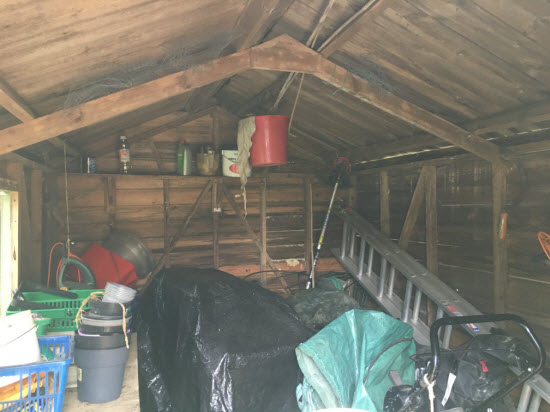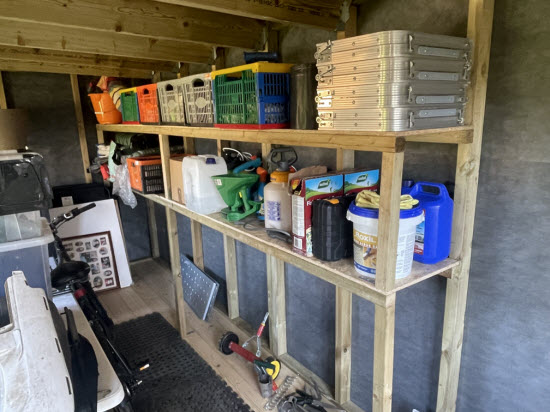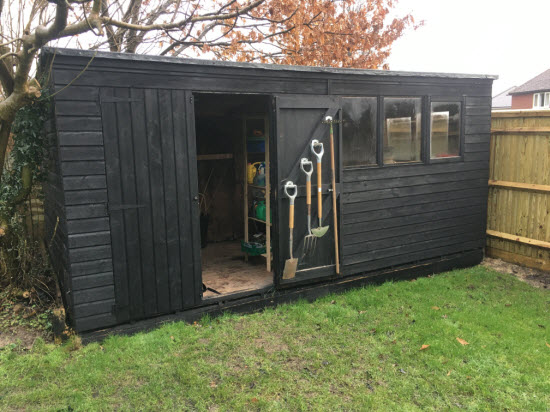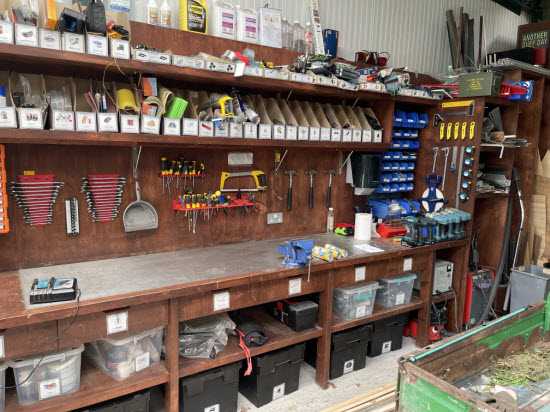Shelving Ideas That Actually Work — Based on the Type of Shed You Have
What the Rake Told Me
Shelving ideas were the last thing on my mind when I was standing in a customer's shed, trying to hang a rake back on the wall. The problem was, there was no hook. There was a hook for a hoe, and another one half-covered by a folding chair - but no obvious spot for a rake.
It was a good shed. Well built. Plenty of space. But it had that cluttered, slightly irritated feel - the kind where every job takes five minutes longer than it should.
That's when it hit me: shelving isn't just storage. It's decision-making in advance. It's how a shed tells you where things go, how to find them, and how to put them back. And that's what this article is about.
 Does your shed look like this? Discover your sheds true purpose and help it to help you with better shelving and organisation
Does your shed look like this? Discover your sheds true purpose and help it to help you with better shelving and organisation
What This Article Is About
This page is a practical guide to shed shelving ideas - but not in the Pinterest sense. We're looking at real, usable systems for storing what you actually own in the kind of shed you already have.
Whether you're storing household overflow, gardening gear, or using your shed as a working tool space, this article will help you:
- Identify the shelving style that suits your shed's job
- Avoid wasted space and rummaging frustration
- Choose between building your own or buying ready-made shelving
- Link to detailed advice for your exact situation
We'll cover the three main shed types - storage, garden, and tool sheds - and give you solid next steps for each.
Shed Shelving Is Not One-Size-Fits-All
It's easy to think of shelving as universal - some brackets, a few planks, and you're done. But the truth is, shelving only works well when it matches the job the shed is doing.
A shed that stores your old files and Christmas lights needs a different layout than one that holds muddy garden tools. And if you're cutting timber or fixing bikes in there? That's a whole different workflow.
In this article, we'll break shed shelving down into three practical categories:
- Storage Shed Shelving - For bins, boxes, and long-term overflow from the house
- Garden Shed Shelving - For tools, chemicals, cables, and lawn care gear
- Tool Shed Shelving - For fixings, power tools, and anything that helps you get jobs done
Each has its own challenges, and each benefits from a different approach. The next three sections will show you what works best - and link you to guides with the details.
Storage Shed Shelving Ideas: Make It Visible, Stable, and Stackable
Storage sheds tend to become the overflow space for everything the house can't hold - holiday decorations, archived paperwork, camping gear, spare duvets. That's fine, but without the right shelving, you'll end up with a wall of mystery bins and a narrow goat path down the middle.
The key here is deep, sturdy shelving that fits standard-sized plastic bins. You want each bin to be easy to grab, clearly labelled, and stackable if needed - but not buried three deep where you'll never reach the back one. Keep everything off the floor to avoid damp and pest issues.
Label both the bin and the shelf, and store the most-used stuff between waist and eye level. Seasonal items and 'just in case' gear can go higher or lower.
 Storage Shed Shelving with space for large boxes
Storage Shed Shelving with space for large boxes
Coming soon - Storage Shed Shelving Ideas
Garden Shed Shelving Ideas: Tools, Chemicals, and Rodent-Proofing
Garden sheds deal with a different kind of chaos: muddy tools, leaky feed bags, sharp implements, and cables that tangle like brambles. The shelving in here needs to work harder - it must be wipeable, strong, and thoughtfully divided.
Use narrow wall shelves for gloves, string, labels, and seed trays. Store hand tools in labelled bins, or hang them near the door where they're easiest to grab. Power tools and extension cables benefit from deep shelves with easy access - and don't forget to leave space near a power socket if you need to charge batteries.
Keep chemicals like fertiliser or pesticide high up, in plastic trays or lipped shelves. And if you're storing anything edible (like bird seed), use rodent-proof metal bins with tight lids - cardboard and soft plastics won't stop a determined mouse.
 Making room for garden shed shelving by having frequently used tools to hand - hanging on the back of the door in this case
Making room for garden shed shelving by having frequently used tools to hand - hanging on the back of the door in this case
Find out more about my Garden Shed Shelving Ideas
Tool Shed Shelving Ideas: Think Like a Tradesperson
If your shed is a workspace - not just a storage spot - then shelving needs to do more than hold stuff. It has to support how you work.
Start by keeping your most-used tools at waist to eye level - where you can grab them without reaching or bending. Heavy gear lives low. Rarely used items go up high. That one rule will eliminate a ton of unnecessary faffing.
Set up a dedicated charging shelf near a power socket, with space for batteries, chargers, and cordless tools. Use shallow shelves or bins near your bench for screws, glues, blades, and consumables - the stuff that always ends up under something else.
And if you really want to feel like the space is helping you work faster? Add a wall-mounted cleat or pegboard system to keep tools visible and off the bench.
 Well labelled and zoned tool shed shelving
Well labelled and zoned tool shed shelving
Find out more about my Tool Shed Shelving Ideas here
Two Ways to Get It Done: Build or Buy
Once you know the kind of shelving you need, the next decision is how to get it in place: build it yourself, or buy it ready-made.
DIY shelving is perfect if you want flexibility, custom sizing, or a rugged build that doesn't cost much. A simple frame of 2x4s and OSB can hold serious weight and last for years. It also means you can build around awkward spaces - under benches, in corners, or around windows.
Shop-bought systems shine when you want clean lines, modularity, or a fast setup. Boltless racking systems, wire shelving, and garage kits are widely available and surprisingly strong - great for household storage or lighter garden gear.
In reality, most sheds benefit from a mix of both: DIY for the core structure, off-the-shelf for bins, inserts, or drawer units.
Find out How to build shelving for your shed
Find out more about ready madeKeter Shelving
One Upgrade at a Time
It's easy to put off improving your shed because it feels like an all-or-nothing job. But the truth is, just one upgrade can change how you use the space.
Add a single new shelf at the right height. Label one chaotic bin. Clear the floor under your bench. Set up a tray for all those loose batteries and chargers. Small changes like these take minutes - and they pay off every time you step into the shed.
Sheds don't become efficient overnight. They become better through small, thoughtful improvements that make the next job easier than the last.
If you're not sure where to start, go back to the last time you felt frustrated in your shed - and fix that moment first.
Conclusion: A Shed That Works Like a Thoughtful Assistant
Back in that customer's shed - the one with no hook for the rake - the problem wasn't space. It was that the shelving hadn't been designed with real use in mind.
That's what good shelving ideas are really about. Not just holding stuff, but removing obstacles. Making tools easier to reach. Helping others put things back. Saving you from one more small frustration.
Whether your shed is storing boxes, feeding the garden, or helping you build things, the right shelving turns it into a space that works with you - not against you.
Pick the kind of shed you have. Explore the ideas that fit. And start small. The best shed systems don't come from planning for perfection - they come from fixing what's not working, one shelf at a time.

Keep in touch with our monthly newsletter
Shed Building Monthly



